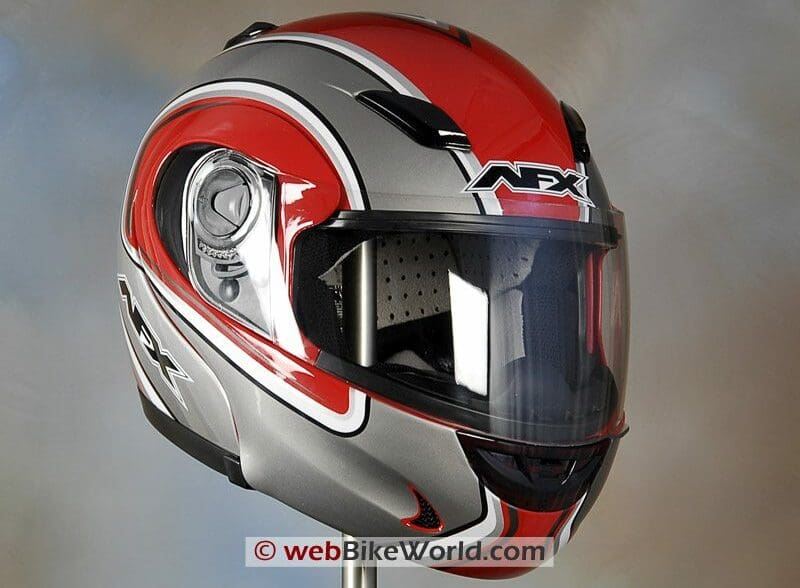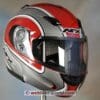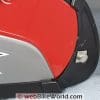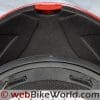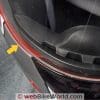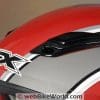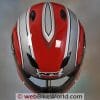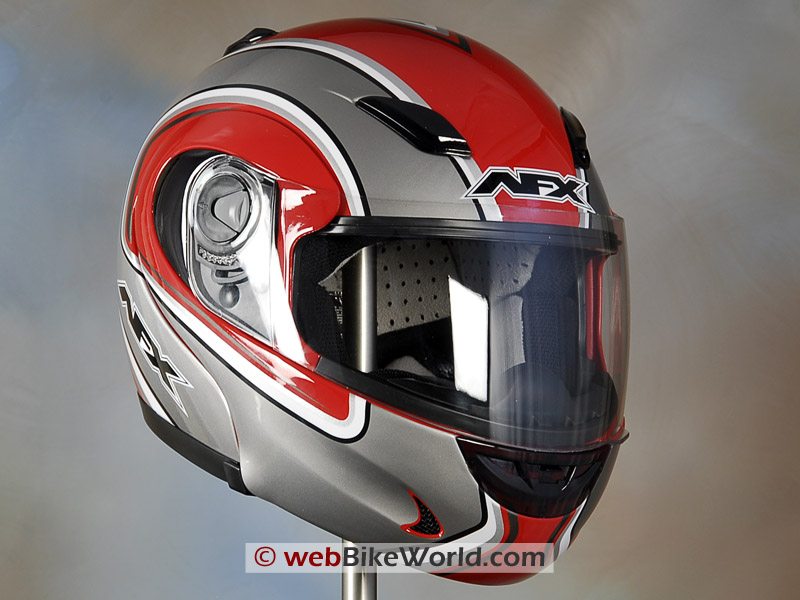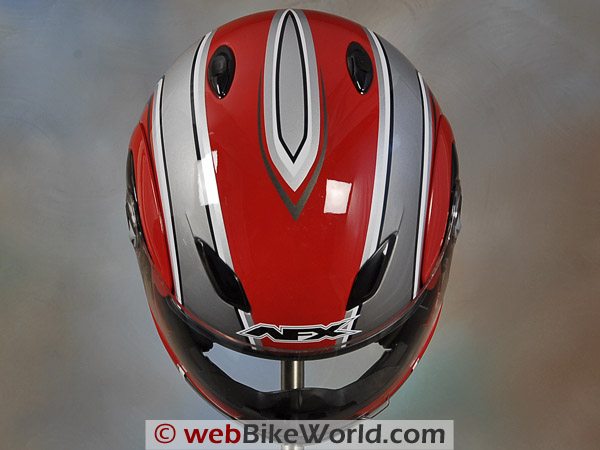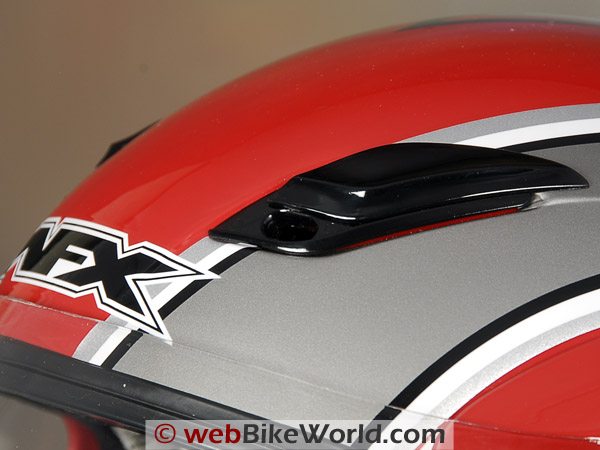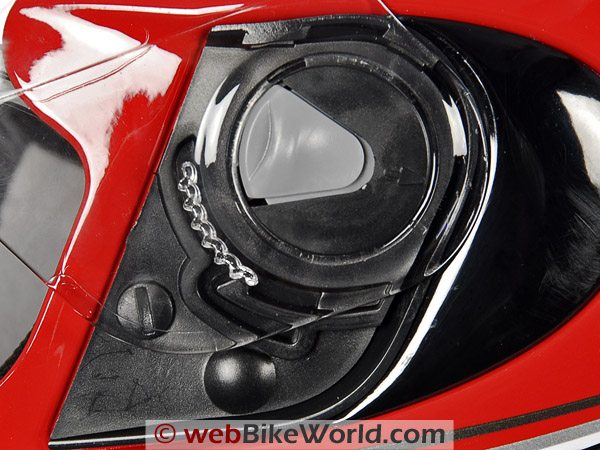Middle-of-the-road flip-up that could use improvement.
When I think of motorcycle helmets, AFX isn’t the first brand that comes to mind.
AFX probably won’t like me saying that, but I guess I’m not really sure where they fit in the motorcycle helmet hierarchy.
I only know that the company has been in business for some time and the AFX helmets I’ve encountered are made in Taiwan.
But I’ve actually never seen an AFX helmet for sale in a motorcycle shop — at least in any of the shops that I frequent.
The helmets apparently compete on price.
But that can be a tough neighborhood to travel in lately, because over the past year some very nice, very high quality helmets have appeared from a variety of manufacturers, all at very reasonable prices, too.
Take, for example, the SparX S-07 (review) or the fantastic GMAX GM68S (review) or even the Zox Azuma R (review), which are all very nice helmets indeed, especially considering their $100 to $150 or so price range.
Any cheaper than that, and — pardon the generalizing and stereotyping here — you’re asking for trouble.
But the competition is so fierce in this segment of the market that rock-bottom pricing alone won’t cut it.
A manufacturer must also have super-high quality and a unique feature set to make their product stand out from the crowd.
AFX FX-28 Details
So what about the new-for-2008 AFX FX-28 helmet?
Well, it’s difficult to compare this one with the three examples I mentioned above, because the FX-28 is a modular helmet — and modular helmets have a unique set of manufacturing quirks and quality control issues.
So it’s probably not fair to compare it to our other favorite inexpensive helmets.
The $144.95 list price (at the date of publication) for the AFX FX-28 is very reasonable for a flip-up helmet, and the helmet has a couple of pretty nice features, but I can say one thing with certainty: it doesn’t have a lot of flash.
This is a pretty basic flip-up helmet, probably most comparable to the AGV Miglia flip-up we reviewed last year.
I’ve been disappointed recently with the selection of modular helmets. I honestly thought this segment of the market would really take off and it hasn’t.
I thought we’d have all sorts of interesting and unique engineering solutions and technology brought to bear by now, but, alas, this hasn’t happened either.
But I guess the same could be said for motorcycle helmets in general — after all, how long have they been using EPS in helmet liners?
The stuff appears to be the same foam used to make those cheap imitation belly boards sold at boardwalk beach stores for $2.99.
You mean to tell me there’s no modern replacement for EPS? How about some type of memory foam, or high-tech squeegee foam with a variable firming rates based on impact severity and duration?
Or how about something like tiny little sealed packets of liquid to spread out the impact while keeping you cool in summer and warm in winter?
For flip-ups, how about a titanium mesh helmet visor framework that locks securely into the helmet shell when the visor is closed to make it stronger than a full-face helmet?
I’m just dreaming here, but my point is that flip-up helmet technology is basically going nowhere. In general, they’re noisy, heavy and seemingly less safe than the best full-face helmets, and they all seem creaky and drafty to me also.
Maybe I’ve been wearing too many good full-face helmets lately…
Paint, Graphics and Overall Quality
The graphics and paint on the AFX FX-28 are done rather well, based on this example.
The “Red Multi” pattern shown here is, believe it or not, pretty radical for a flip-up helmet.
For some reason, most flip-up helmets, no matter who makes them, have much more conservative styling than their full-face cousins, that’s for sure.
A good example of this is the new Vemar Jiano, which has probably the most limited color selection we’ve ever seen: basic gray, black or matte silver.
The “Red Multi” gloss pattern shown here isn’t bad, and the same graphics can be had in flat black, pearl white, blue and silver themes. The helmet is also available in solid colors for $5.00 less, including gloss black, flat black, pearl white and red.
The graphics and the finish is nicely applied and the gloss clear coat seems thick.
The decals are placed under the clear coat, giving the helmet a more finished look. The red, silver and the pinstripes all go together rather well, so at least this is a flip-up with a modicum of style anyway.
However, it does seem like the gloss clear coat is softer than normal; the helmet already has a few scratches here and there.
I’ve done nothing other than put it down on a table and normal handling — I don’t think I’ve abused it in any way.
Everything on the helmet is lined up evenly; there are no obvious fit and finish issues on the helmet shell or the liner. Note that AFX offers a lifetime warranty on the FX-28, which is very unusual for a motorcycle helmet.
I do have a concern though. The helmet looks OK, but the quality of the parts themselves and the overall execution are a bit disappointing to me. For example, the helmet seems to have a lot of lateral flexibility.
When the rotating visor is closed and latched, I can squeeze the helmet and it flexes, both at the shell and around the sides of the chin bar on the rotating visor. You can see this in the video below.
We’ve experienced flexing like this on occasion in other modular helmets and even in some full-face helmets.
The FX-28 is claimed to meet both DOT and ECE safety standards, which is great, so I guess the only thing we can assume is that the helmet is structurally sound. But the flexibility is somewhat troubling, to me anyway.
Overall, considering only the finish and the graphics and the way everything is put together, I’d say that the FX-28 certainly doesn’t knock me over, but it’s very good for the price.
Score: I’ll give the FX-28 an “Excellent” rating in my book for the paint and graphics and a “Good” for individual parts quality. See the ratings scale in the summary table at the bottom of this page.
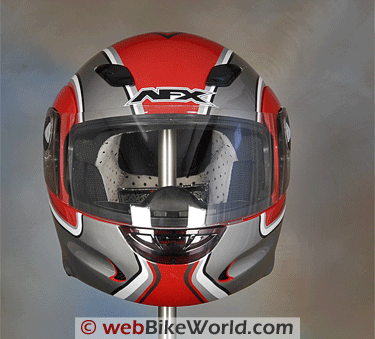
Helmet Shape and Fit
The AFX FX-28 shown here is a size XL. We try to purchase all of the reviewed helmets in the same size to keep the evaluations and weight comparisons on an equal footing.
The helmet fits about maybe just a touch small for an XL, which is actually a good thing in a modular helmet.
The shell on a modular helmet usually will stretch a bit because of the loss of integrity when the flip-up front is raised.
So it’s probably better to start off just a touch small with a helmet of this type — in other words, if you’re in-between sizes, I’d say go for the smaller size, rather than the larger.
I think the helmet has a round internal shape. I can usually stick my finger up along my forehead and feel some space or movement on helmets that have a more neutral fit, and I don’t feel this when wearing the FX-28.
The liner feels like it contacts my head evenly all around.
This is in contrast to the Vemar Jiano, which has a different internal shape, tending towards “neutral”; that is, it’s on the long oval side of round.
See the wBW Motorcycle Helmet FAQ for more information on choosing and fitting a motorcycle helmet and for a discussion regarding human head shapes. Don’t forget that choosing the correct helmet shape is crucial to fit, comfort and safety!
The AFX FX-28 is available in sizes ranging from XS to XXL, but it’s not clear how many shell sizes span this range; I’d guess two.
The lining is…OK (there’s that word again). It’s rather basic, it has minimal padding, and the material isn’t as plush as I’ve felt. It’s about as low-end as I’d care to go on a motorcycle helmet. I’ve felt worse — but that isn’t saying much.
The liner fabric feels soft, and it seems to have more “stiction” than I’m used to and I’m not sure why. It sort of grips my skin more than the lining on other helmets, and it doesn’t feel like it transfers moisture as well as other liners.
This may or may not be a problem, depending upon the owner’s sensitivity to such things.
AFX says that the material used in the liner and the cheek pads is “hypo-allergenic and antimicrobial nylon” and both the liner and cheek pads are removable and washable (although I can’t confirm this).
The helmet has a separate section of lining and padding in the lower rear. Many helmets have a separate section of padding in the neck roll in this area, but it can become a problem if the separation between this rear section and the sides of the helmet is too large.
The rear of a helmet forms a low pressure region, and air can get sucked up into that space and it can cause noise and unwanted venting.
This is somewhat of an issue on the FX-28, and the rear padded section feels strange to me, because when I squeeze it, I can feel that the foam EPS liner doesn’t meet the bottom of the helmet shell.
And when the padding is squeezed, it gives off a sort of crinkly noise, like there’s some type of strange plastic material inside the liner.
The ear pockets in the liner are unlined, but the pockets aren’t very big. I suppose a set of speakers could be mounted inside with double-sided tape.
I have no problems slipping the helmet over my head when wearing a pair of eyeglasses or sunglasses.
Score: The AFX FX-28 gets a “Good” for comfort.
Ventilation
The FX-28 has a basic array of vents; nothing fancy, but they seem to all work, after a fashion anyway. The chin vent has a simple “up/down” cover, but it feels rather flimsy and it’s missing strong detents to hold it in place.
Fortunately, the down position is open, so if the weak detents fail, at least the vent will be open.
It’s usually hard to tell whether any motorcycle helmet vents actually do anything, and more so on a modular helmet.
A lot of air comes up from under the chin bar and from the back of the helmet, making it difficult to determine how much is being contributed by the vents only.
The AFX FX-28 isn’t the worst in this regard.
But it sure does seem to invite the not-too-balmy breezes up under the bottom of the helmet, where they blow around and keep my neck extra chilled in the winter while the circulating air both dries up my eyes and makes them tear at the same time, if you can imagine.
The air from the chin vent is theoretically directed up to the breath guard, which is also rather loose, but as long as it isn’t disturbed, it seems to stay put.
The breath guard acts as a splitter, with most of the air directed up on to the back of the visor and the rest towards the rider’s face.
The chin bar also includes two screen-covered vents, but it seems as if these are just for show.
They apparently do not direct the air to the inside of the helmet, and there’s a section of rubbery padding in back of the chin bar that blocks the air anyway, although I suppose there could be a channel or something molded inside.
The top of the FX-28 features two independent vents. These are also rather basic but they do seem to work — slide them back to open and forward to close. Simple.
Two exhaust vents are located at the back of the helmet, and these also have slider covers to open or close the vents.
The top vents and the rear exhaust vents are, I think, supposed to have two positions; half open and full open (or three positions if you count “closed”).
But the middle position has such a weak detent that it’s hard to tell.
The top vents do appear to flow some air into the helmet, and the liner is perforated (and actually surprisingly thick on top), so I’d say the top venting is acceptable.
Score: The FX-28 gets a “Very Good” for venting and air flow.
Face Shield and Rotating Flip-up Visor
OK, let’s talk about the visor for a minute. The clear visor is good; it has good optical qualities and it has strong detents that hold it open in one of six positions.
It also seems to have better anti-fog capabilities than several other helmets we’ve tried recently; in fact, in a back-to-back comparison of the FX-28, the Shark RSX and the Vemar Jiano, the FX-28 visor came out on top, almost like it was impervious to fog.
Don’t forget that visor anti-fog capabilities will vary, depending upon temperature and humidity, but on that particular day, the FX-28’s visor was the champ.
The clear visor can be removed rather easily, with yet another type of visor removal system.
This one is relatively straightforward: lift the visor until a molded-in line matches up with an arrow on the visor removal mechanism, then push in the lever and remove the visor. It’s illustrated in the video below.
However, the lower portion of the clear visor does not meet the eye port gasket (yellow arrow, photo below).
The eye port gasket does not completely surround the eye port, due to the design of the rotating visor, but the gasket along the bottom lip of the eye port is about 3 mm away from the visor, leaving a space.
As a result, the visor has enough flexibility to be pushed side-to-side.
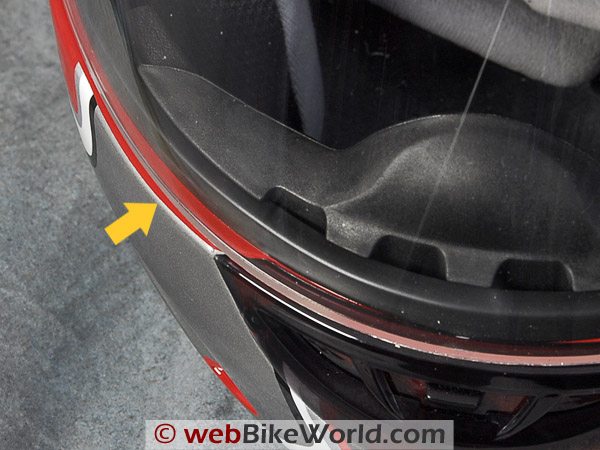
In practice though, this so far hasn’t caused a problem. I’d guess that the helmet might be quieter if the visor sealed against the gasket, as it normally does.
It’s just another area where the AFX doesn’t quite equal some of the competition.
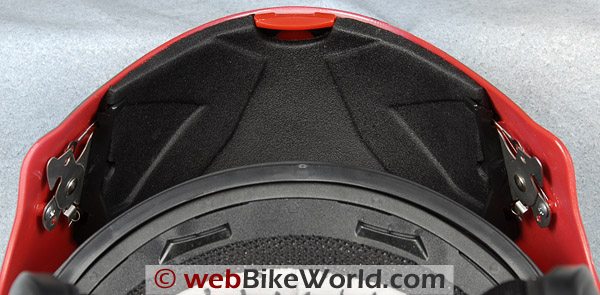
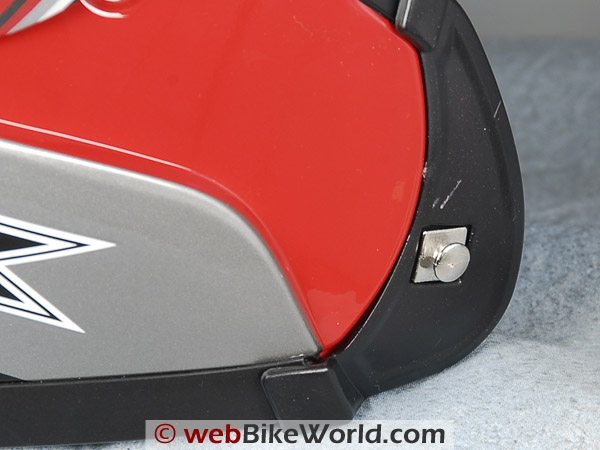
This is illustrated in the photos below and also in the video. This is a good feature, missing on flip-up helmets like the Zox Nevado and others.
The metal isn’t very robust, but it does hold the visor closed — I can’t pull it apart like I can on the Zox.
The tab to release the rotating visor is located in the center, under the chin bar.
It must be pulled down to unlock the visor, and it feels slightly balky, probably because it’s pulling against the springs that hold the metal latches.
So the FX-28 gets extra points for an all-metal rotating visor latch system, but it loses a few for the lack of attention to detail on the clear visor and in the lateral flexibility of the rotating visor assembly.
Score: I’ll give it a “Good” overall in this area.
Noise Levels
This is where the AFX FX-28 is rather surprising. After all the creaking and flexibility and errant air flow, you’d think the helmet would be as loud as they come. But it isn’t that bad, actually.
It’s certainly not the quietest helmet I’ve ever tried by any means, but it’s probably about average overall and I’d say it’s on the quiet side for a modular helmet.
The top vents don’t create much noise, nor do they cause the whistling noise that’s common when air rushes over a hole.
I haven’t noticed much low-frequency “booming” noise also around the bottom of the helmet when riding behind a fairing, but this may be the result of helmet design serendipity rather than a deliberate attempt to smooth out airflow in this area.
So overall, the FX-28 seems to be normal to slightly quiet when compared to other modular helmets. See the wBW Motorcycle Helmet Noise page for more information.
Also, note that we always wear high-quality, correctly fitted ear plugs when riding. Please see thewBW Earplugs and Hearing Protection page for more information on choosing and wearing earplugs.
If you don’t wear ear plugs, all bets are off — every motorcycle helmet is dangerously noisy, in our opinion, and your hearing is as precious as your eyesight, so don’t mess with it. Wear ear plugs.
Score: I’ll give the FX-28 a “Very Good” rating for noise control, but note that perceived noise levels will vary, depending upon fit, head shape, motorcycle type, windscreens and even the rider’s clothing.
Helmet Weight
The AFX FX-28 in size XL weighs 1716 grams (3 lbs., 12-1/2 oz.). This puts it at 68 of the 88 helmets we’ve reviewed as of this date. The FX-28 feels heavy to me, and it’s also slightly top heavy, which is typical of modular helmets.
See the wBW Motorcycle Helmet Weights page for a chart comparing the weights of every helmet we’ve reviewed.
The AFX is about as heavy as the HJC CL-SP (1713 grams); the Shoei Syncrotec Police (1731); theScorpion EXO-700 at 1733 grams and the Joe Rocket RKT 101 at 1737 grams.
So actually, I guess in a certain sense it’s either a plus that the FX-28 weighs only as much as some full-face helmets (modular helmets are typically heavier), or it’s a shame that those full-face helmets aren’t lighter.
Score: The FX-28 gets a “Good” for slightly beefy weight that seems to be distributed in a way that gives the helmet a high center of gravity.
Miscellaneous
The FX-28 has D-ring connectors for the helmet strap and a snap to hold the loose piece of strap. As mentioned above, AFX offers a lifetime warranty on this helmet.
The FX-28 meets both DOT and ECE helmet safety standards, but it’s marked only as one or the other, depending upon the country where it is being sold.
Conclusion
The AFX FX-28 is a decent modular helmet that doesn’t really have any standout features, in my opinion.
I guess if you’re really limited on funds and you really want a modular helmet, it would probably be acceptable.
But I’d suggest that you’d be better off with one of the very nice full-face helmets mentioned above that are available for about the same price.
|
wBW Review: AFX FX-28 Helmet
|
|
|---|---|
| Manufacturer: AFX Helmets | List Price (2008): $139.95 to $144.95 |
| Colors: Flat black, pearl white, blue, red and silver graphics. Solid colors in gloss black, flat black, pearl white and red. | Made In: Taiwan |
| Sizes: XS to XXL. Shell Sizes: Unknown | Review Date: March 2008 |
Owner Comments and Feedback
See details on submitting comments.


